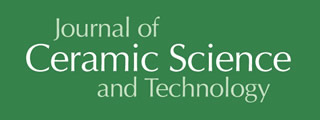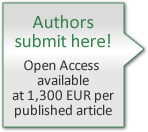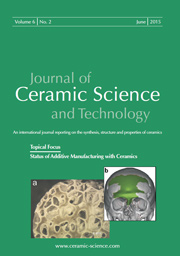Articles
All articles | Recent articles
Preparation and Characterization of Reticulated Porous Mullite Coated with Radar-Absorbing Material
S. Lee1,2, J.-H. Ha1, J. Lee1, I.-H. Song1, B. Park3, S. B. Lee3, S.-H. Kwon2
1 Powder and Ceramics Division, Korea Institute of Materials Science, 797 Changwondaero, Seongsan-gu, Changwon, Gyeongsangnam-do, 51508, Republic of Korea
2 School of Materials Science and Engineering, Pusan National University, 2 Busandaehak-ro 63beon-gil, Geumjeong-gu, Busan, 46241, Republic of Korea
3 Composites Research Division, Korea Institute of Materials Science, 797 Changwondaero, Seongsan-gu, Changwon, Gyeongsangnam-do, 51508, Republic of Korea
received December 2, 2019, received in revised form February 19, 2020, accepted March 2, 2020
Vol. 11, No. 1, Pages 62-72 DOI: 10.4416/JCST2019-00076
Abstract
Porous ceramics have received much attention because they have excellent thermal and chemical properties. Among the porous ceramics, reticulated porous ceramics (RPCs) have been fabricated for many years. However, as far as the authors know, knowledge of the radar-absorbing properties of RPCs remains insufficient. The authors discussed the feasibility of RPCs, prepared using mullite, as a potential platform that could be coated with a radar-absorbing material (RAM). The results of the experiments in this study were used to determine (1) whether RAM-coated reticulated porous mullite (RPM) could be fabricated with acceptable mechanical strength, and (2) whether RPM could be coated with a RAM while retaining acceptable radar-absorbing properties. Therefore, the structural properties of RPM and the radar-absorption properties of RPM after application of RAM coating were discussed. The compressive strengths of the RPM could be enhanced by controlling the pore densities of commercial polyurethane foams (polymer template) and sintering temperature. The calculated reflection loss (RL) of the 5.74-mm-thick RPM, coated with 10 wt% carbon slurry, approached – 40 dB (99.99 % absorption of radar wave) at 10.0 GHz. The calculated RL of the 17.32-mm-thick RPM, coated with 30 wt% cobalt slurry, approached – 35 dB (99.90 % absorption of the radar wave) at 10.0 GHz.
![]() Download Full Article (PDF)
Download Full Article (PDF)
Keywords
Reticulated porous ceramics, mullite, carbon, cobalt, radar-absorption properties
References
1 Studart, A.R., Gonzenbach, U.T., Tervoort, E., Gauckler, L.J.: Processing routes to macroporous ceramics: A Review, J. Am. Ceram. Soc., 89, 1771 – 1789, (2006).
2 Gonzenbach, U.T., Studart, A.R., Steinlin, D., Tervoort, E., Gauckler, L.J.: Processing of particle-stabilized wet foams into porous ceramics, J. Am. Ceram. Soc., 90, 3407 – 3414, (2007).
3 Santhosh, B., Vakifahmetoglu, C., Ionescu, E., Reitz, A., Albert, B., Sorarù, G.D.: Processing and thermal characterization of polymer derived SiCN(O) and SiOC reticulated foams, Ceram. Int., 46, 5594 – 5601, (2020).
4 Chen, R., Jia, W., Lao, D., Li, S., Hei, D.: Preparation of novel reticulated porous ceramics with hierarchical pore structures, J. Alloy. Compd., 806, 596 – 602, (2019).
5 Yue, H., Wang, X., Tian, J.: Fabrication of Si3N4 reticulated porous ceramics reinforced by needle-like β-Si3N4, Ceram. Int., 40, 8525 – 8532, (2014).
6 Voigt, C., Zienert, T., Schubert, P., Aneziris, C.G., Hubálková, J.: Reticulated porous foam ceramics with different surface chemistries, J. Am. Ceram. Soc., 97, 2046 – 2053, (2014).
7 Liang, X., Li, Y., Liu, J., Sang, S., Chen, Y., Li, B., Aneziris, C.G.: Improvement of the mechanical properties of SiC reticulated porous ceramics with optimized three-layered struts for porous media combustion, Ceram. Int., 43, 3741 – 3747, (2017).
8 Voigt, C., Jäckel, E., Aneziris, C.G., Hubálková, J.: Investigations of reticulated porous alumina foam ceramics based on different coating techniques with the aid of μCT and statistical characteristics, Ceram. Int., 39, 2415 – 2422, (2013).
9 Betke, U., Lieb, A., Scheffler, F., Scheffler, M.: Manufacturing of reticulated open-cellular aluminum nitride ceramic foams from aqueous aln suspensions, Adv. Eng. Mater., 19, 1600660, (2016).
10 Zhu, X., Jiang, D., Tan, S., Zhang, Z.: Improvement in the strut thickness of reticulated porous ceramics, J. Am. Ceram. Soc., 84, 1654 – 1656, (2001).
11 Pu, X., Liu, X., Qiu, F., Huang, L.: Novel method to optimize the structure of reticulated porous ceramics, J. Am. Ceram. Soc., 87, 1392 – 1394, (2004).
12 Bueno, A.R., Gregori, M.L., Nóbrega, M.C.S.: Microwave-absorbing properties of Ni0.50-xZn0.50-xMe2xFe2O4 (Me=Cu, Mn, Mg) ferrite-wax composite in X-band frequencies, J. Magn. Magn. Mater., 320, 864 – 870, (2008).
13 Song, N., Gu, S., Wu, Q., Li, C., Zhou, J., Zhang, P., Wang, W., Yue, M.: Facile synthesis and high-frequency performance of CoFe2O4 nanocubes with different size, J. Magn. Magn. Mater., 451, 793 – 798, (2018).
14 Choi, I., Lee, D., Lee, D.G.: Radar absorbing composite structures dispersed with nano-conductive particles, Compos. Struct., 122, 23 – 30, (2015).
15 Munir, A.: Microwave radar absorbing properties of multiwalled carbon nanotubes polymer composites: A Review, Adv. Polym. Technol., 36, 362 – 370, (2017).
16 Vasconcelos da Silva, L., Pezzin, S.H., Cerqueira Rezende, M., Campos Amico, S.: Glass fiber/carbon nanotubes/epoxy three-component composites as radar absorbing materials, Polym. Compos., 37, 2277 – 2284, (2016).
17 Pinto, S.S., Rezende, M.C.: Morphological, electromagnetic, and absorbing properties of POMA and PAni/Carbon black composites, J. Electron. Mater., 46, 4939 – 4947, (2017).
18 Gupta, K.K., Abbas, S.M., Abhyankar, A.C.: Carbon black/polyurethane nanocomposite-coated fabric for microwave attenuation in X & Ku-band (8 – 18 GHz) frequency range, J. Ind. Text., 46, 510 – 529, (2016).
19 Teber, A., Unver, I., Kavas, H., Aktas, B., Bansal, R.: Knitted radar absorbing materials (RAM) based on nickel-cobalt magnetic materials, J. Magn. Magn. Mater., 406, 228 – 232, (2016).
20 Poorbafrani, A., Kiani, E.: Enhanced microwave absorption properties in cobalt-zinc ferrite based nanocomposites, J. Magn. Magn. Mater., 416, 10 – 14, (2016).
21 Osendi, M.I., Baudín, C.: Mechanical properties of mullite materials, J. Eur. Ceram. Soc., 16, 217 – 224, (1996).
22 Schneider, H., Schreuer, J., Hildmann, B.: Structure and properties of mullite – A review, J. Eur. Ceram. Soc. 28, 329 – 344, (2008).
23 Munro, R.G.: Evaluated material properties for a sintered alpha-alumina, J. Am. Ceram. Soc., 80, 1919 – 1928, (1997).
24 Biswas, P., Varaprasad, K., Ramavath, P., Suresh, M.B., Khanra, A.K., Johnson, R.: Development of cordierite based reticulated foams with improved mechanical properties for porous burner applications, Trans. Indian Ceram. Soc., 76, 56 – 61, (2017).
25 Ha, J.-H., Lee, S., Choi, J.R., Lee, J., Song, I.-H., Lee, S.J., Choi, J.: Development of a carbon-coated reticulated porous alumina material with tailored structural properties for potential radar-absorption applications, Ceram. Int., 43, 16924 – 16930, (2017).
26 Pasternack, R.M., Rivillon Amy, S., Chabal, Y.J.: Attachment of 3-(Aminopropyl)triethoxysilane on silicon oxide surfaces: dependence on solution temperature, Langmuir, 24, 12963 – 12971, (2008).
27 Jakša, G., Štefane, B., Kovač, J.: Influence of different solvents on the morphology of APTMS-modified silicon surfaces, Appl. Surf. Sci., 315, 516 – 522, (2014).
28 Tang, H., Yao, S., Shen, X., Xi, X., Xiao, K.: Lithium-Sulfur batteries with high rate and cycle performance by using multilayered separators coated with Ketjen Black, Energy Technology, 5, 623 – 628, (2017).
29 Wang, D., Shen, Y., Zhang, X., Wu, Z.: Enhanced hydrogen evolution from the MoP/C hybrid by the modification of Ketjen Black, J. Mater. Sci., 52, 3337 – 3343, (2017).
30 Colombo, P.: Conventional and novel processing methods for cellular ceramics, Philos. T. R. Soc. A, 364, 109 – 124, (2006).
31 Zou, T., Wu, Y., Li, H.: Electromagnetic and microwave absorbing properties of carbon-encapsulated cobalt nanoparticles, Mater. Lett., 214, 280 – 282, (2018).
32 Meng, X.M., Zhang, X.J., Lu, C., Pan, Y.F., Wang, G.S.: Enhanced absorbing properties of three-phase composites based on a thermoplastic-ceramic matrix (BaTiO3 + PVDF) and carbon black nanoparticles. J. Mater. Chem. A, 2, 18725 – 18730, (2014).
33 Smitha, P., Singh, I., Najim, M., Panwar, R., Singh, D., Agarwala, V., Das Varma, G.: Development of thin broad band radar absorbing materials using nanostructured spinel ferrites, J. Mater. Sci.: Mater. Electron., 27, 7731 – 7737, (2016).
34 Micheli, D., Apollo, C., Pastore, R., Marchetti, M.: X-Band microwave characterization of carbon-based nanocomposite material, absorption capability comparison and RAS design simulation, Compos. Sci. Technol., 70, 400 – 409, (2010).
35 Xi, J., Zhou, E., Liu, Y., Gao, W., Ying, J., Chen, Z., Gao, C.: Wood-based straightway channel structure for high performance microwave absorption, Carbon, 124, 492 – 498, (2017).
36 Kolanowska, A., Janas, D., Herman, A.P., Jędrysiak, R.G., GiŻewski, T., Boncel, S.: From blackness to invisibility – Carbon nanotubes role in the attenuation of and shielding from radio waves for stealth technology, Carbon, 126, 31 – 52, (2018).
37 Liu, X., Zhang, Z., Wu, Y.: Absorption properties of carbon black/silicon carbide microwave absorbers, Compo. Part B: Eng., 42, 326 – 329, (2011).
38 Du, Y., Liu, W., Qiang, R., Wang, Y., Han, X., Ma, J., Xu, P.: Shell thickness-dependent microwave absorption of core-shell Fe3O4@C composites, ACS Appl. Mater. Inter., 6, 12997 – 13006, (2014).
39 Kong, L., Yin, X., Zhang, Y., Yuan, X., Li, Q., Ye, F., Cheng, L., Zhang, L.: Electromagnetic wave absorption properties of reduced graphene oxide modified by maghemite colloidal nanoparticle clusters, J. Phys. Chem. C 117, 19701 – 19711, (2013).
40 Kong, I., Hj Ahmad, S., Hj Abdullah, M., Hui, D., Nazlim Yusoff, A., Puryanti, D.: Magnetic and microwave absorbing properties of magnetite-thermoplastic natural rubber nanocomposites, J. Magn. Magn. Mater., 322, 3401 – 3409, (2010).
41 Wang, B., Wei, J., Yang, Y., Wang, T., Li, F.: Investigation on peak frequency of the microwave absorption for carbonyl iron/epoxy resin composite, J. Magn. Magn. Mater., 323, 1101 – 1103, (2011).
Copyright
Göller Verlag GmbH


